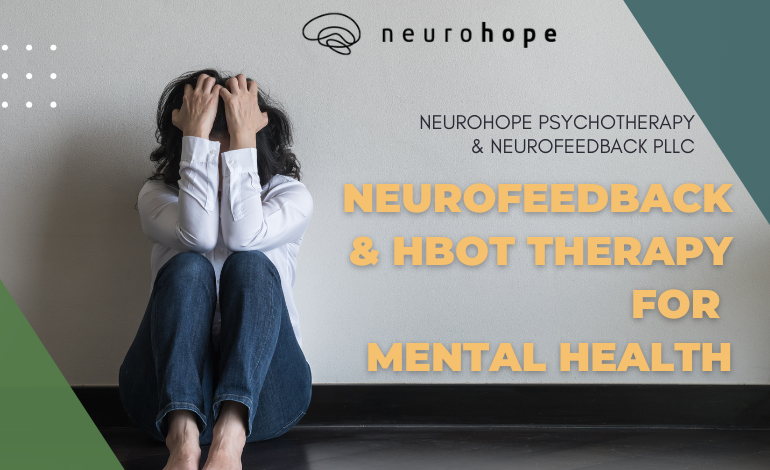
Mental health challenges, such as anxiety, depression, and trauma, affect millions of people worldwide. Traditional treatments like therapy and medication are effective, but the emergence of unique therapies like neurofeedback therapy trains the brain to regulate its activity, and hyperbaric oxygen therapy (HBOT) involves breathing pure oxygen in a pressurized chamber, offering promising new ways to support mental health.
These treatments work by harnessing the brain’s adaptability and leveraging the healing power of oxygen, making them potential game-changers in mental healthcare.
What is Neurofeedback Therapy?
Neurofeedback therapy in Colorado Springs, a biofeedback, focuses on training the brain to regulate its activity. By using real-time brainwave data, individuals can learn to control and optimize their brain function.
How Neurofeedback Works
During a neurofeedback session, sensors are placed on the scalp to monitor brain activity. This data is displayed through visual or auditory cues, allowing patients to adjust their brainwaves consciously. Over time, this feedback helps reinforce positive patterns and reduce maladaptive brain activity.
Types of Neurofeedback Techniques
-
Traditional neurofeedback: Focuses on frequency-based training.
-
QEEG-guided neurofeedback: Uses brain mapping for targeted interventions.
-
Infra-low frequency training: Works on deep brain regulation for emotional balance.
Understanding Hyperbaric Oxygen Therapy (HBOT)
HBOT involves breathing pure oxygen in a pressurized chamber. This process increases the amount of oxygen in the blood, promoting healing and improving brain function.
How HBOT Works
Under pressure, oxygen dissolves more efficiently into the bloodstream, reaching areas with reduced blood flow. This enhanced oxygen delivery supports cellular repair, reduces inflammation, and improves overall brain health.
The Role of Oxygen in Brain Function
Oxygen is essential for brain cells to produce energy. Increased oxygen levels can boost neuroplasticity, the brain’s ability to form new connections, which is crucial for mental health recovery.
The Connection Between Neurofeedback and HBOT
Complementary Mechanisms of Action
Neurofeedback enhances brainwave regulation, while HBOT supports the physical healing of brain tissue. Together, they target both functional and structural aspects of brain health.
Synergistic Effects on Brain Health
The combined use of these therapies amplifies their benefits. For instance, neurofeedback may improve mental clarity, while HBOT accelerates recovery by reducing inflammation and increasing oxygen supply.
Evidence-Based Benefits
Clinical studies show that combining neurofeedback with HBOT can significantly improve symptoms of PTSD, anxiety, and cognitive impairment, offering hope for those who haven’t responded to traditional treatments.
Benefits of Neurofeedback for Mental Health
Reducing Anxiety and Stress
Neurofeedback helps calm overactive brain regions associated with stress, fostering relaxation and resilience.
Enhancing Focus and Cognitive Performance
Neurofeedback improves attention, memory, and problem-solving skills by optimizing brainwave patterns.
Treating Mood Disorders
For conditions like depression, neurofeedback can stabilize mood by promoting balance in brainwave activity.
Benefits of Hyperbaric Oxygen Therapy for Mental Health
Supporting Neuroplasticity
HBOT enhances the brain’s ability to rewire, which is particularly beneficial for trauma recovery and learning difficulties.
Reducing Inflammation in the Brain
Chronic inflammation is linked to mental health issues. HBOT counteracts this by promoting anti-inflammatory responses.
Accelerating Recovery from Trauma
Whether it’s physical or emotional trauma, HBOT aids healing by improving blood flow and oxygen delivery to affected areas.
Combining Neurofeedback Therapy and HBOT Therapy
Case Studies and Clinical Trials
Research highlights the effectiveness of combining these therapies, with patients reporting improved mood, better focus, and faster recovery from brain injuries.
Who Can Benefit the Most?
Individuals with PTSD, traumatic brain injuries, and treatment-resistant depression are prime candidates for this dual approach.
Practical Applications in Therapy
Clinics are now integrating neurofeedback and HBOT into comprehensive treatment plans, tailoring sessions to individual needs for maximum impact.
Challenges and Limitations
Access and Affordability
These therapies can be costly and aren’t always covered by insurance, limiting their accessibility.
Potential Side Effects
While generally safe, neurofeedback and HBOT may cause mild side effects like headaches or fatigue, which professionals should monitor.
Need for Professional Supervision
Trained practitioners are not just beneficial, but essential to ensure the safety and efficacy of these treatments. Professional supervision is a key factor in the successful implementation of neurofeedback and HBOT.
Future Directions
Advances in Neurofeedback Technology
Innovations like AI-driven neurofeedback are making treatments more precise and accessible.
Expanding Accessibility of HBOT
Efforts are underway to reduce costs and improve the availability of HBOT chambers in community healthcare settings.
Integrative Approaches to Mental Health
Combining neurofeedback and HBOT with traditional therapies can create a holistic mental health strategy.
Conclusion
Neurofeedback therapy and Colorado Springs hyperbaric oxygen therapy represent groundbreaking advancements in mental health treatment. By addressing both the functional and structural aspects of brain health, these therapies have the potential to revolutionize the field, intriguing individuals seeking alternative solutions to mental health challenges. Their potential to change the game makes them true game-changers in the field.
FAQs
What conditions can neurofeedback and HBOT treat?
They are effective for PTSD, anxiety, depression, ADHD, and brain injury recovery.
How soon can results be expected?
Results vary, but many individuals notice improvements after a few sessions.
Are these therapies safe for everyone?
Generally, yes, but a consultation with a healthcare professional is crucial to ensure suitability.
Do these therapies replace medication?
They complement traditional treatments and may reduce dependency on medication over time.
How can I find a professional provider?
Search for certified neurofeedback practitioners and accredited HBOT clinics in your area.